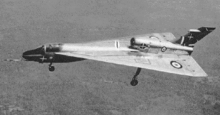
Concorde is a retired Anglo-French supersonic airliner jointly developed and manufactured by Sud Aviation and the British Aircraft Corporation (BAC). Studies started in 1954, and France and the UK signed a treaty establishing the development project on 29 November 1962, as the programme cost was estimated at £70 million . Construction of the six prototypes began in February 1965, and the first flight took off from Toulouse on 2 March 1969. The market was predicted for 350 aircraft, and the manufacturers received up to 100 option orders from many major airlines. On 9 October 1975, it received its French Certificate of Airworthiness, and from the UK CAA on 5 December.

A delta wing is a wing shaped in the form of a triangle. It is named for its similarity in shape to the Greek uppercase letter delta (Δ).
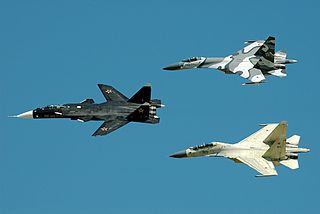
A swept wing is a wing angled either backward or occasionally forward from its root rather than perpendicular to the fuselage.
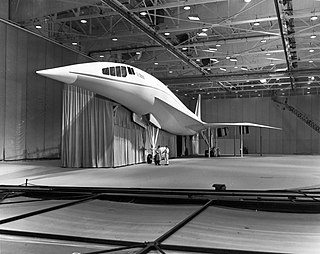
The Lockheed L-2000 was Lockheed Corporation's entry in a government-funded competition to build the United States' first supersonic airliner in the 1960s. The L-2000 lost the contract to the Boeing 2707, but that competing design was ultimately canceled for political, environmental and economic reasons.

The Bristol Type 223 was an early design for a supersonic transport. In the late 1950s and early 1960s the Bristol Aeroplane Company studied a number of models as part of a large British inter-company effort funded by the government. These models eventually culminated in the Type 223, a transatlantic transport for about 100 passengers at a speed around Mach 2. At about the same time Sud Aviation in France was developing the similar Super-Caravelle design, and in November 1962 the efforts were merged to create the Concorde project.

The Bristol Type 188 is a supersonic research aircraft designed and produced by the British aircraft manufacturer Bristol Aeroplane Company. It was nicknamed the Flaming Pencil in reference to its length and relatively slender cross-section as well as its intended purpose.

The Rolls-Royce Olympus was the world's second two-spool axial-flow turbojet aircraft engine design, first run in May 1950 and preceded only by the Pratt & Whitney J57, first-run in January 1950. It is best known as the powerplant of the Avro Vulcan and later models in the Concorde SST.

The Avro 707 is an experimental aircraft designed and produced by the British aircraft manufacturer Avro.

The Fairey Delta 2 or FD2 is a British supersonic research aircraft that was produced by the Fairey Aviation Company in response to a specification from the Ministry of Supply for a specialised aircraft for conducting investigations into flight and control at transonic and supersonic speeds. Features included a delta wing and a drooped nose. On 6 October 1954, the Delta 2 made its maiden flight, flown by Fairey test pilot Peter Twiss; two aircraft would be produced. The Delta 2 was the final aircraft to be produced by Fairey as an independent manufacturer.
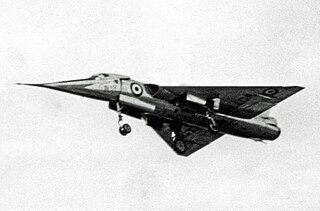
The droop nose, drooped nose or droop snoot is a feature fitted to a small number of aircraft types so the nose of the aircraft can be lowered during takeoff and landing to improve the pilot's view of the ground below. This feature is used with a very-low aspect ratio wing such as a delta wing. It is installed in aircraft capable of supersonic speeds but is lowered only during low-speed operation such as takeoff and landing.

A supersonic aircraft is an aircraft capable of supersonic flight, that is, flying faster than the speed of sound. Supersonic aircraft were developed in the second half of the twentieth century. Supersonic aircraft have been used for research and military purposes, but only two supersonic aircraft, the Tupolev Tu-144 and the Concorde, ever entered service for civil use as airliners. Fighter jets are the most common example of supersonic aircraft.

Vortex lift is that portion of lift due to the action of leading edge vortices. It is generated by wings with highly sweptback, sharp, leading edges or highly-swept wing-root extensions added to a wing of moderate sweep. It is sometimes known as non-linear lift due to its rapid increase with angle of attack. and controlled separation lift, to distinguish it from conventional lift which occurs with attached flow.

The Lippisch DM-1 was a single-seat research glider that was designed and built in Germany from 1944.

The wing configuration of a fixed-wing aircraft is its arrangement of lifting and related surfaces.
The Handley Page H.P.22 and H.P.23 were single-seat sport monoplanes produced for the 1923 Lympne light aircraft trials. They were not successful.
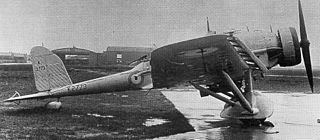
The Handley Page H.P.47 was a British single-engined low-wing monoplane built to an Air Ministry specification for a general-purpose bomber and torpedo bomber aircraft. Only one was built.

The Handley Page H.P.20 was an experimental monoplane modification of a de Havilland DH.9A, built to study controllable slots and slotted ailerons as high lift devices. It was the first aircraft to fly with controllable slots.
John Cochrane was a British test pilot for the Anglo-French supersonic airliner, Concorde.

Johanna Weber was a German-born British mathematician and aerodynamicist. She is best known for her contributions to the development of the Handley Page Victor bomber and the Concorde.




